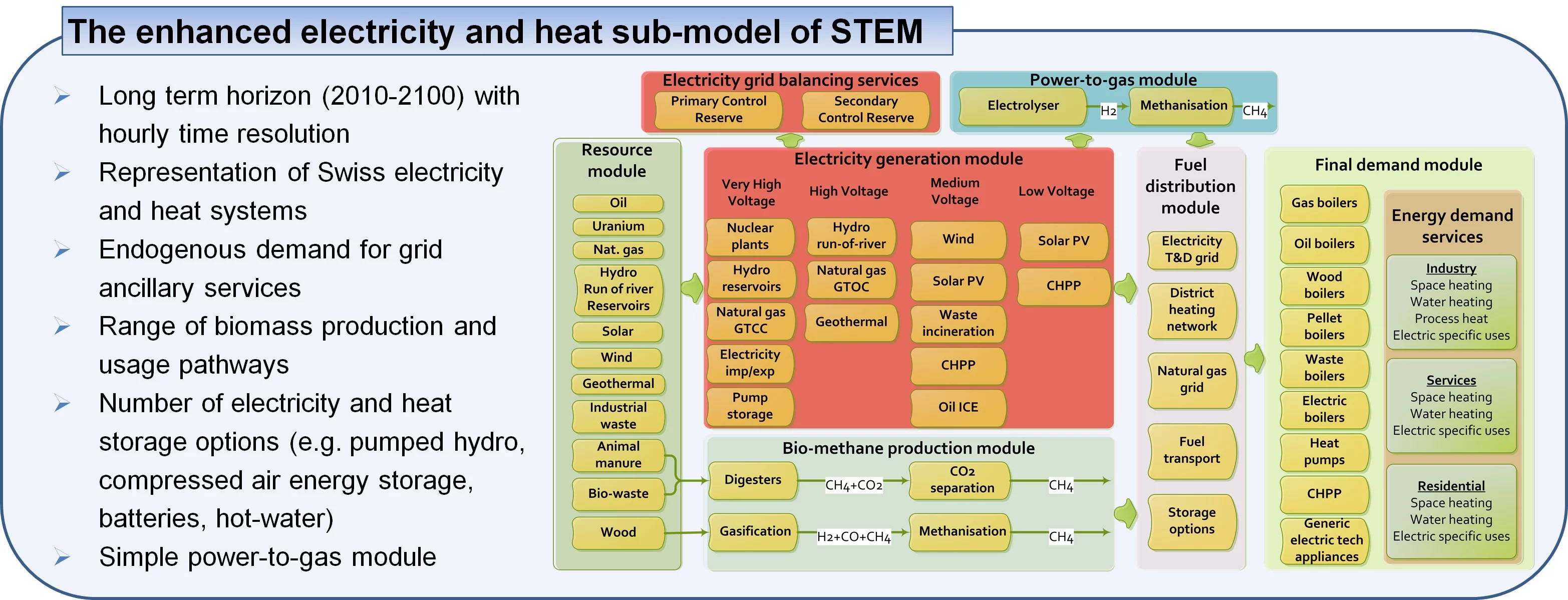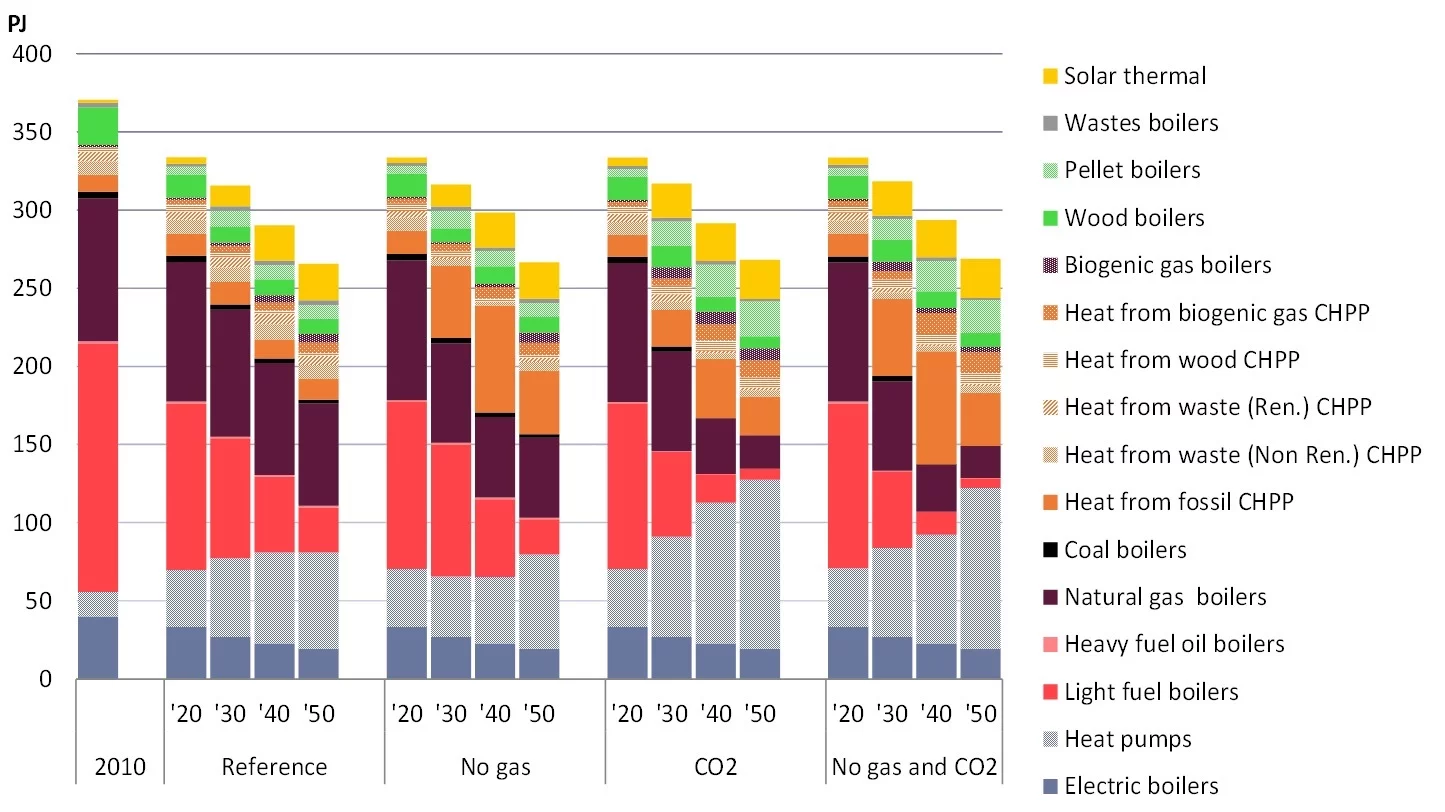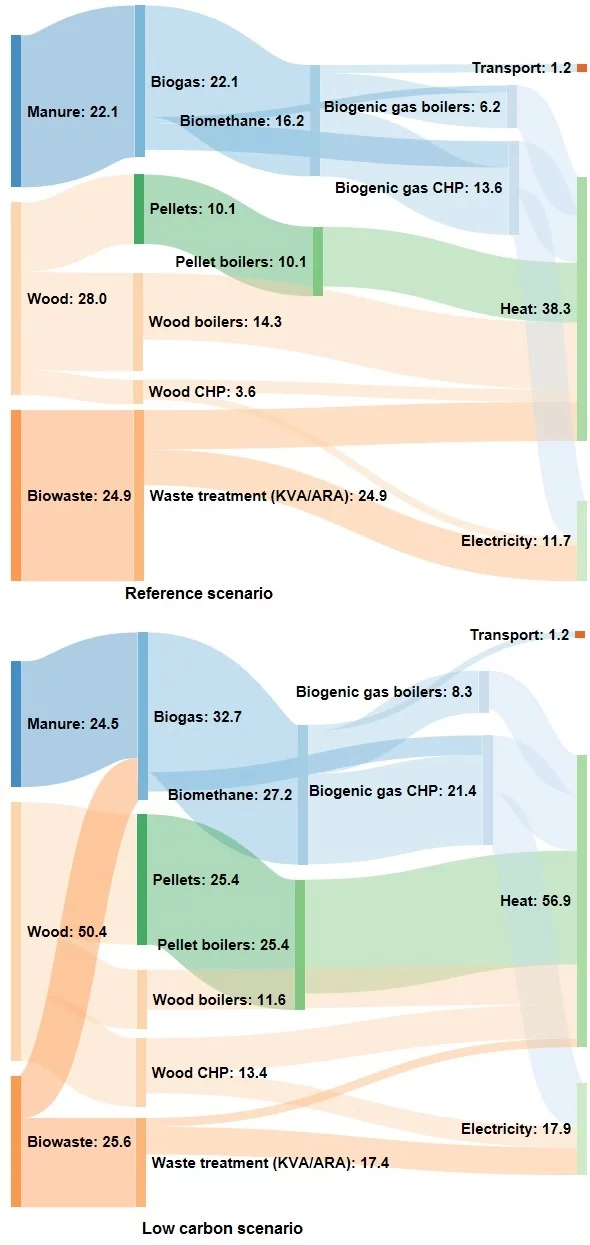System modelling for assessing the potential of decentralised biomass-CHP plants to stabilise the Swiss electricity network with increased fluctuating renewable generation
The CHP Swarm project focused on assessing the potential of decentralised biomass-based combined heat and power (CHP) plants as: a) an electricity grid stabilisation measure to manage an increasing share of intermittent renewable electricity production and b) as a "power on demand" option able to cover shortages of renewable generation over long periods while simultaneously covering heat demand.
It is envisaged that decentralised biogenic combined heat and power (CHP) plants could play a significant role in responding to the challenges facing the Swiss power system by providing more flexibility to balance production and consumption. The potential of this concept was assessed by the development of a CHP swarm model based on detailed technical plant specifications and GIS information regarding the resources and infrastructure, complemented by electricity grid simulation and long-term scenario analysis of the entire Swiss electricity and heat system.
We evaluated the prospects of biomass in stationary applications and grid balancing from an energy system perspective. Bioenergy includes energy from woody biomass (such as forest wood, industrial wood residues, wood from landscape maintenance and waste wood) and wet biomass (food waste, green waste, industrial bio-waste, sewage sludge, animal manure). We enhanced the electricity and heat sectors of the Swiss TIMES Energy Systems Model (STEM), as well as the biomass production and end use pathways. The scenario analysis shows that domestic biomass can contribute 5 – 7% in electricity and 14 – 21% in heat production by 2050.
An overview of the enhanced electricity and heat sub-model of STEM
It is envisaged that decentralised biogenic combined heat and power (CHP) plants could play a significant role in responding to the challenges facing the Swiss power system by providing more flexibility to balance production and consumption. The potential of this concept was assessed by the development of a CHP swarm model based on detailed technical plant specifications and GIS information regarding the resources and infrastructure, complemented by electricity grid simulation and long-term scenario analysis of the entire Swiss electricity and heat system.
We evaluated the prospects of biomass in stationary applications and grid balancing from an energy system perspective. Bioenergy includes energy from woody biomass (such as forest wood, industrial wood residues, wood from landscape maintenance and waste wood) and wet biomass (food waste, green waste, industrial bio-waste, sewage sludge, animal manure). We enhanced the electricity and heat sectors of the Swiss TIMES Energy Systems Model (STEM), as well as the biomass production and end use pathways. The scenario analysis shows that domestic biomass can contribute 5 – 7% in electricity and 14 – 21% in heat production by 2050.
An overview of the enhanced electricity and heat sub-model of STEM

Long term heat supply in various scenarios

Bioenergy production and use pathways in the “Reference” and “Low carbon” scenarios

Relevant publications
Marcucci,A., Kypreos, S., Panos, E. (2017). The road to achieving the long-term Paris targets: energy transition and the role of direct air capture, Climatic Change, https://doi.org/10.1007/s10584-017-2051-8
Collins, S., Dean, JP, Poncelet, K., Panos, E., Pietzcker, R., Delarue, E., Ó Gallachóir, B. (2017). Integrating short term variations of the power system into integrated energy system models: A methodological review, Renewable and Sustainable Energy Reviews, Vol. 76, pp. 839-856, http://dx.doi.org/10.1016/j.rser.2017.03.090
Panos, E., Kannan, R. (2016). The role of domestic biomass in electricity, heat and grid balancing markets in Switzerland, Energy, Vol. 112, pp. 1120-1138, DOI:10.1016/j.energy.2016.06.107
Vögelin P., Panos E., Buffat R., Becutti G., Kannan R., et al. (2016). System modelling for assessing the potential of decentralised biomass-CHP plants to stabilise the Swiss electricity network with increased fluctuating renewable generation, Final report of the Swiss Federal Office of Energy.
Margelou, S. (2015). Assessment of long term solar PV diffusion in Switzerland – Agent-based diffusion model for single family houses, Master Thesis, EPFL, Download (1.5MB)
Collins, S., Dean, JP, Poncelet, K., Panos, E., Pietzcker, R., Delarue, E., Ó Gallachóir, B. (2017). Integrating short term variations of the power system into integrated energy system models: A methodological review, Renewable and Sustainable Energy Reviews, Vol. 76, pp. 839-856, http://dx.doi.org/10.1016/j.rser.2017.03.090
Panos, E., Kannan, R. (2016). The role of domestic biomass in electricity, heat and grid balancing markets in Switzerland, Energy, Vol. 112, pp. 1120-1138, DOI:10.1016/j.energy.2016.06.107
Vögelin P., Panos E., Buffat R., Becutti G., Kannan R., et al. (2016). System modelling for assessing the potential of decentralised biomass-CHP plants to stabilise the Swiss electricity network with increased fluctuating renewable generation, Final report of the Swiss Federal Office of Energy.
Margelou, S. (2015). Assessment of long term solar PV diffusion in Switzerland – Agent-based diffusion model for single family houses, Master Thesis, EPFL, Download (1.5MB)
Presentations
Panos, E., Margelou, S. (2017). Modelling the long-term solar PV penetration in single- and two- family houses in Switzerland, Energy Systems Modelling and Optimisation Workshop, Prague , Czech Republic, Presentation
Panos E., Kannan R. (2016). Long-term national electricity and heat supply scenarios, CHPSWARM project communication event, ETH Zurich, Switzerland, Poster
ETH, PSI (2016). Potenzialanalyse eines Schwarms biogener Wärmekraftkoppelungsanlagen zur Kompensation fluktuierender erneuerbarer Stromquellen, CHPSWARM project communication event, ETH Zurich, Switzerland, Presentation
Panos, E., Kannan, R. (2015). Can the decentralized CHP generation provide the flexibility required to integrate intermittent RES in the electricity system?, 67th Semi-Annual IEA-ETSAP meeting, Abu Dhabi, UAE, Presentation
For more information see CHP SWARM Project
Panos E., Kannan R. (2016). Long-term national electricity and heat supply scenarios, CHPSWARM project communication event, ETH Zurich, Switzerland, Poster
ETH, PSI (2016). Potenzialanalyse eines Schwarms biogener Wärmekraftkoppelungsanlagen zur Kompensation fluktuierender erneuerbarer Stromquellen, CHPSWARM project communication event, ETH Zurich, Switzerland, Presentation
Panos, E., Kannan, R. (2015). Can the decentralized CHP generation provide the flexibility required to integrate intermittent RES in the electricity system?, 67th Semi-Annual IEA-ETSAP meeting, Abu Dhabi, UAE, Presentation
For more information see CHP SWARM Project
